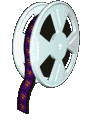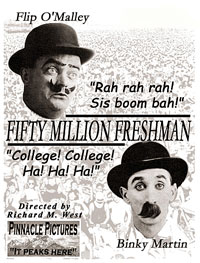
The Blorple Falls chapter
of the West Carolina Cinema Enthusiasts League (est. 1974)
is proud to present
The Second Annual Blorple Falls



and SUV Showcase

The Blorple Falls chapter
of the West Carolina Cinema Enthusiasts League (est. 1974)
is proud to present



A HISTORY OF PINNACLE PICTURES
Humble Beginnings
Pinnacle Pictures began in 1918, when Morty Hack won the studio in a card game. Always a step behind the latest trend and a level below the standards of quality and taste, Pinnacle was never more than a constant supply of filler aimed at the cheapest common denominator. The motto, "Pinnacle: It Peaks Here," was more than a trifle ironic.
A former unlicensed fish-peddler and Eastern European immigrant ("Not Russia!"), Hack has been described as both a "ruthless, heartless, conniving little bastard," and a "humorless gnat of a man" (by his mother on her death-bed). In truth, he was a bit of both. He stood 4-foot-3-inches tall, but wore lifts in his shoes that made him appear 4-foot-6. Hack felt that a man 4-foot-6 was three inches more intimidating than a man 4-foot-3.
The only "asset" that came with the acquisition of Pinnacle was a catalog of Happy Gay two-reelers. Unfortunately, Happy came along as well.
Billed as "500 Pounds of Fun!" Happy Gay was an immensely large comedian whose stock-in-trade gave new meaning to the word "excess." Though one critic of the day called him "neither funny nor fit," Happy had at one time been a popular attraction in the Music Halls of England, largely as a subject of mockery. Forced to leave that country under still-questionable circumstances, Happy arrived in California and was immediately signed by the Sidney J. Proctor Motion Picture Company to an exclusive contract for the then-impressive salary of $40,000 a year. By 1918, however, he was well past his prime.
Hack tried to make a go of it with Gay, but the public wasn't having any more of the dangerously obese funnyman. Hack tried to force Happy into dieting, then tried to make him gain weight. ("Happy Gay—Bigger & Better!" shouted one poster.)
Finally, stuck with an expensive drain on his resources, Hack manufactured a lurid scandal involving the now-depressive comedian and Hack's own niece, Jinx Jocelyn, Happy's constant co-star, so that he could invoke the morality clause in the star's contract. Within weeks, Happy was through.
Disgraced and under indictment, Happy fled to Mexico. Interestingly, he fled not with the niece, but with Hack's 14-year-old nephew, Charles. Jinx Jocelyn made at least two dozen more one-reel comedies until Hack fired her a week later.
The Peak Years
The bulk of the Pinnacle output, though, was the O'Malley & Martin series.Flip O'Malley and Binky Martin were a pair of failed vaudevillians who somehow managed to extend their limited abilities into a film career. In 1926, they signed what even their own agent called "the worst contract in the history of show business," and found themselves making a picture a week for the next 27 years.
During their reign as "The World's Ugliest Comedy Team," O'Malley & Martin churned out an unbelievable 1,350 two-reel comedies. (In an attempt to make the team sound more palatable, the moniker was later changed to "The World's Most Unusual Comedy Team.")
Typical O'Malley & Martin one-sheets. Left, a 1927 short. It was their 108th comedy since submitting to the yoke of Pinnacle servitiude the year before. Right: Considerably older but no wiser, O&M confront the Atomic Age on their own terms in 1948's "Atomic Bums."
Most of the hundreds of O&M films have been lost, destroyed, or purposely tossed in the trash by outraged theater owners. Even after making so many motion pictures, the pair died in abject poverty—a state in which they had been living since 1928. Hack missed both funerals due to golf engagements.
Decline and Conquer
But Hack's greatest achievement, his biggest coup, had nothing to do with the production of film at all. It was when he sold the entire Pinnacle catalog to television in the early '50s.He, and he alone, made millions—a figure that easily dwarfed the total budgets of all 127,351 films produced by Pinnacle between 1918 and 1953. In a 1979 telephone interview with Charles Foster Lovewell, former Pinnacle editor Smokey Edson explained: "The crazy thing is, less than three years after the sale, you couldn't find a Pinnacle Picture showing anywhere on the tube. Not on a single station. They'd stunk up the airwaves so much in such a short period of time that nobody would dare to show one. As usual, Morty got the last laugh. He just took the money and ran."
At right, a local cowboy attempts to drum up business for the Esquire Theater in June of 1953. The Esquire was the sole survivor in the Pinnacle theater chain, a chain that once boasted a total of two theaters and partial ownership in a drive-in. Morty Hack would close down the Esquire later that summer, just prior to the sale of the Pinnacle film library to television. While Mr. Hack never actually produced an "adult" film, he had no moral qualms about running such fare in his theaters. "If it has sprocket holes, I will show it," he once bragged. In fact, it was Morty Hack who invented the "X" rating in the early '50s. An "X" was originally painted on adult-oriented movie posters as a sign to local police that the theater owner had paid his protection money to the local precinct (multiple X's meant that he was paid up until the end of the year). The police would then ignore any community complaints that arose over whatever filth was being shown at his theater. Eventually, in the late '60s, the MPAA adopted the "X" as the official rating for adult films.
Hack eventually lost the lease, and the theater—the final remnant of the Pinnacle Era—was torn down. Local preservationists declined to come to its rescue and the building's remains were pulverized and turned into fertilizer filler.
— from Forgotten Hollywood: The Compleat Films of Pinnacle Pictures,
by Charles Foster Lovewell.HOME MISSION CURATOR'S COMMENT SCHEDULE
OUR SPONSORS BACK TO SLATE